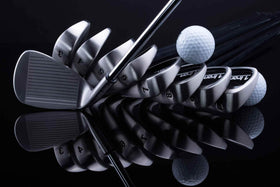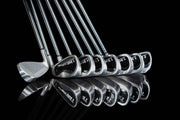The Truth about Golf Club Length
by David Lake
I have been asked many times how I came up with the concept of single length golf clubs over 20 years ago. The fact is that I did not come up with the concept at all, although I was not aware of this during my many years of experimenting, testing, and developing of our line of 1 Iron single length irons and woods. It was later that I learned that a number of companies had offered single length irons in the past and many top pros had played them. Since I knew from my own testing the superiority of single length irons and woods over conventional golf clubs I always wondered why they were not the standard in the industry. The answer finally came to me from an elderly gentleman whose father lead MacGregor Golf Company’s design team back in the 1920’s and 1930’s. He explained to me that all sets of golf clubs were custom built to the same club lengths prior to the introduction of steel shafts (invented in 1910 and legalized in 1926). Prior to that time hickory shafts were the norm and golf clubs were custom fitted/built to a single length within a set based upon the static measurements of the individual golfer (wrist-to-floor measurement). The production and tuning of hickory shafts as well as the rest of the club making process was very time consuming and demanded the skills of highly skilled club makers. Obviously, this was an expensive process and could only be afforded by the wealthy which is why golf originally got the reputation as being a sport only for the very rich and affluent members of society. The advent of the steel shaft changed all of this since sets of golf clubs could now be mass produced very cheaply in factories using unskilled workers. Large sporting goods manufacturers (including MacGregor), along with mail order companies such as Sears and J.C Penny were lured by the huge untapped market for inexpensive sets of golf clubs and jumped in to bring golf to the masses. The only stumbling block was that they could not mass produce these sets while providing single length custom fitting for each individual customer.
The solution came when it was decided to abandon a proper custom fitting entirely and instead simply incorporate a 1/2 inch incremental length progression between successive irons and woods. That way, regardless of the size of the customer, there would be one or two clubs within a set that would come close to fitting anyone who purchased them (a boon to mass production but a serious detriment to the unsuspecting golfer). In other words, the incremental lengths in a set of conventional golf clubs today are the result of a profit motivated mass production decision made in the 1920’s and not based upon any golfing performance criteria whatsoever. It should be noted that hickory shafted golf clubs were also mass produced to a much lesser degree and is why you may find some of these antique sets with varying club lengths.
Now I realize that this story is third-hand to you and I got it second-hand (his father told him), but I have absolutely no reason to doubt it. In fact, it just makes so much sense that I have to believe it entirely. I will add that throughout my many years involved in the golf industry (club design, custom club building, and manufacturing) I have never seen in any book or other treatise on club design a reason given for the standard 1/2 inch incremental club lengths. In fact, the complete omission of any kind of explanation adds tremendous weight to the above story.
I will say that unless you have tried a set of 1 Iron single length golf clubs you have never played clubs that came close to fitting you properly and you certainly have never been able to realize your true golfing potential.










